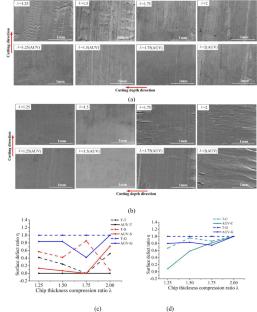Effect of axial ultrasonic vibration on the surface topography and microstructure of Al6061 chip in extrusion cutting
Abstract
In this study, a new process of axial ultrasonic vibration-assisted extrusion cutting (AUV-EC) is proposed to prepare Al6061 alloy ultrafine-grained chip strips. The principles of AUV-EC are analyzed. The cutting motion trajectory equations of the main tool and the constraint tool during the AUV-EC process are established, and the theoretical cut marks on the chip surface are predicted. AUV-EC experiments are conducted to verify the theoretical cut marks on the chip surface and characterize the surface topography and microstructure of the chip strip samples. The results show that applying ultrasonic vibration with a frequency of 33 ~ 34.5 kHz and an amplitude of 1 ~ 6 μm in the AUV-EC process can improve the chip strip’s surface quality. Compared with traditional extrusion cutting (EC) chip samples, AUV-EC chip samples have better surface flatness and smoothness and lower surface defect ratios. The average grain sizes of the traditional EC and AUV-EC chip samples are approximately 164 nm and 135 nm, respectively. Many dynamic recovery grains are distributed in traditional EC chips, but there is only a small amount in AUV-EC chips. The x-ray diffraction (XRD) test finds that the AUV-EC chip has a higher dislocation density.



 求助内容:
求助内容: 应助结果提醒方式:
应助结果提醒方式:


